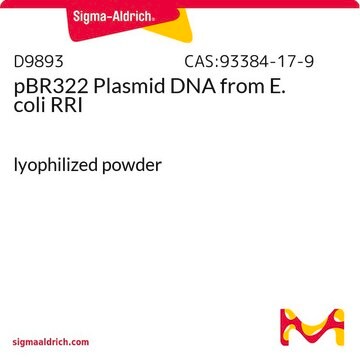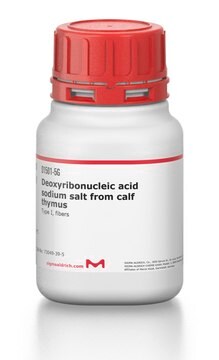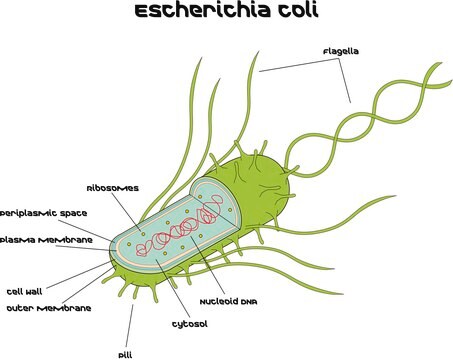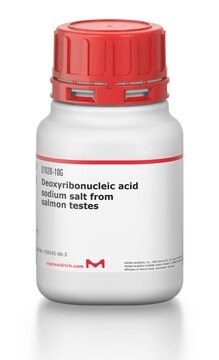D4904
pBR322 Plasmid DNA from E. coli RRI
buffered aqueous solution
Iniciar sesiónpara Ver la Fijación de precios por contrato y de la organización
About This Item
Número de CAS:
Número CE:
Número MDL:
Código UNSPSC:
12352200
eCl@ss:
32160414
NACRES:
NA.51
Productos recomendados
recombinante
expressed in E. coli
Nivel de calidad
grado
for molecular biology
Formulario
buffered aqueous solution
mol peso
2.9 MDa
4363 bp
Origen de replicación
BR322
Selección
ampicillin
Condiciones de envío
dry ice
temp. de almacenamiento
−20°C
¿Está buscando productos similares? Visita Guía de comparación de productos
Descripción general
Plasmid pBR322 was one of the first multipurpose cloning vectors constructed for use in E. coli. This plasmid is derived from the ColE1-type plasmid pMB1 and shares the same type of replication mechanism and controls as ColE1 and relatives. Plasmid pBR322 confers resistance to ampicillin and tetracycline. The plasmid sequence has been published.
The plasmid has unique restriction sites within the gene for ampicillin resistance (Pst I, Pvu I, and Sca I), within the gene for tetracycline resistance (BamH I, BspM I, EcoR V, Nhe I, Nru I, Sal I, Sph I, and Xma III), and elsewhere (Aat II, Ava I, Bal I, Bsm I, BspM II, Cla I, EcoR I, Hind III, Nde I, Pvu II, Ssp I, Sty I, and Tth111 I).
The plasmid has unique restriction sites within the gene for ampicillin resistance (Pst I, Pvu I, and Sca I), within the gene for tetracycline resistance (BamH I, BspM I, EcoR V, Nhe I, Nru I, Sal I, Sph I, and Xma III), and elsewhere (Aat II, Ava I, Bal I, Bsm I, BspM II, Cla I, EcoR I, Hind III, Nde I, Pvu II, Ssp I, Sty I, and Tth111 I).
Especificidad
Unique Sites: Within the gene for ampicillin resistance: Pst I, Pvu I, Sca I; Within the gene for tetracycline resistance: BamH I, BspM I, EcoR V, Nhe I, Nru I, Sal I, Sph I, Xma III; other unique sites: Aat II, Ava I, Bal I, Bsm I, BspM II, Cla I, EcoR I, Hind III, Nde I, Pvu II, Ssp I, Sty I, Tth111 I.
Aplicación
Plasmid pBR322 was one of the first multipurpose cloning vectors constructed for use in Escherichia coli. This plasmid and derivatives have been used for a number of purposes including cloning, selection and expression of recombinant molecules, construction of shuttle vectors and vectors for nucleotide sequencing, studies of elements involved in gene expression, as plasmid DNA standards, and as a model system for studies on prokaryotic plasmid replication.
pBR322 Plasmid DNA from E. coli RRI has been used to study about ferrous ion-induced strand breaks in the plasmid pBR322 are mediated through hydrogen peroxide.
Acciones bioquímicas o fisiológicas
This plasmid is derived from the ColE1-type plasmid pMB1 and shares the same type of replication mechanism and controls as ColE1 and relatives.
Componentes
DNA is provided in a solution of 10 mM Tris-HCl (pH 8.0) with 1 mM EDTA.
Otras notas
Accession number: J01749
Producto relacionado
Referencia del producto
Descripción
Precios
Código de clase de almacenamiento
11 - Combustible Solids
Clase de riesgo para el agua (WGK)
WGK 3
Punto de inflamabilidad (°F)
Not applicable
Punto de inflamabilidad (°C)
Not applicable
Equipo de protección personal
Eyeshields, Gloves, type N95 (US)
Elija entre una de las versiones más recientes:
¿Ya tiene este producto?
Encuentre la documentación para los productos que ha comprado recientemente en la Biblioteca de documentos.
Jörg Flemmig et al.
European biophysics journal : EBJ, 36(4-5), 377-384 (2006-10-19)
Ferrous ion-induced generation of single and multiple strand breaks in the DNA plasmid pBR322 induces the formation of two new plasmid forms with altered electrophoretic mobility. The yield of these plasmid forms, the circular relaxed and the linear forms, depended
Ferrous ion-induced strand breaks in the DNA plasmid pBR322 are not mediated by hydrogen peroxide
Flemmig J and Arnhold J
European Biophysics Journal, 36(4-5), 377-384 (2007)
Charles J Addison et al.
BioTechniques, 37(3), 376-378 (2004-10-09)
Transformation of Escherichia coli plays an important role in recombinant DNA technology. Most current transformation protocols require that the cells be treated to attain a particular physiological state known as "competence," and this makes transformation procedures lengthy and arduous. Here
Nuestro equipo de científicos tiene experiencia en todas las áreas de investigación: Ciencias de la vida, Ciencia de los materiales, Síntesis química, Cromatografía, Analítica y muchas otras.
Póngase en contacto con el Servicio técnico








